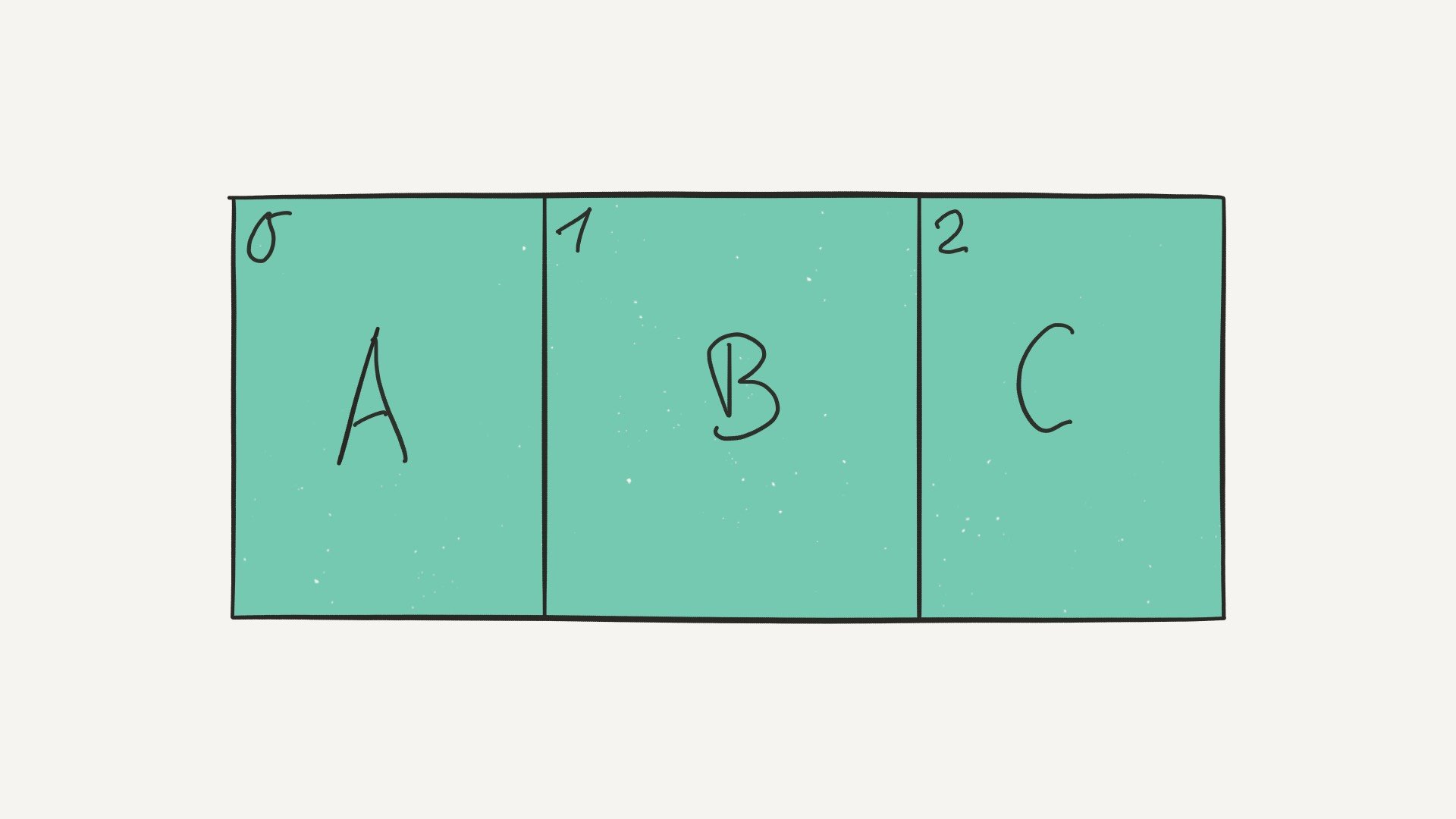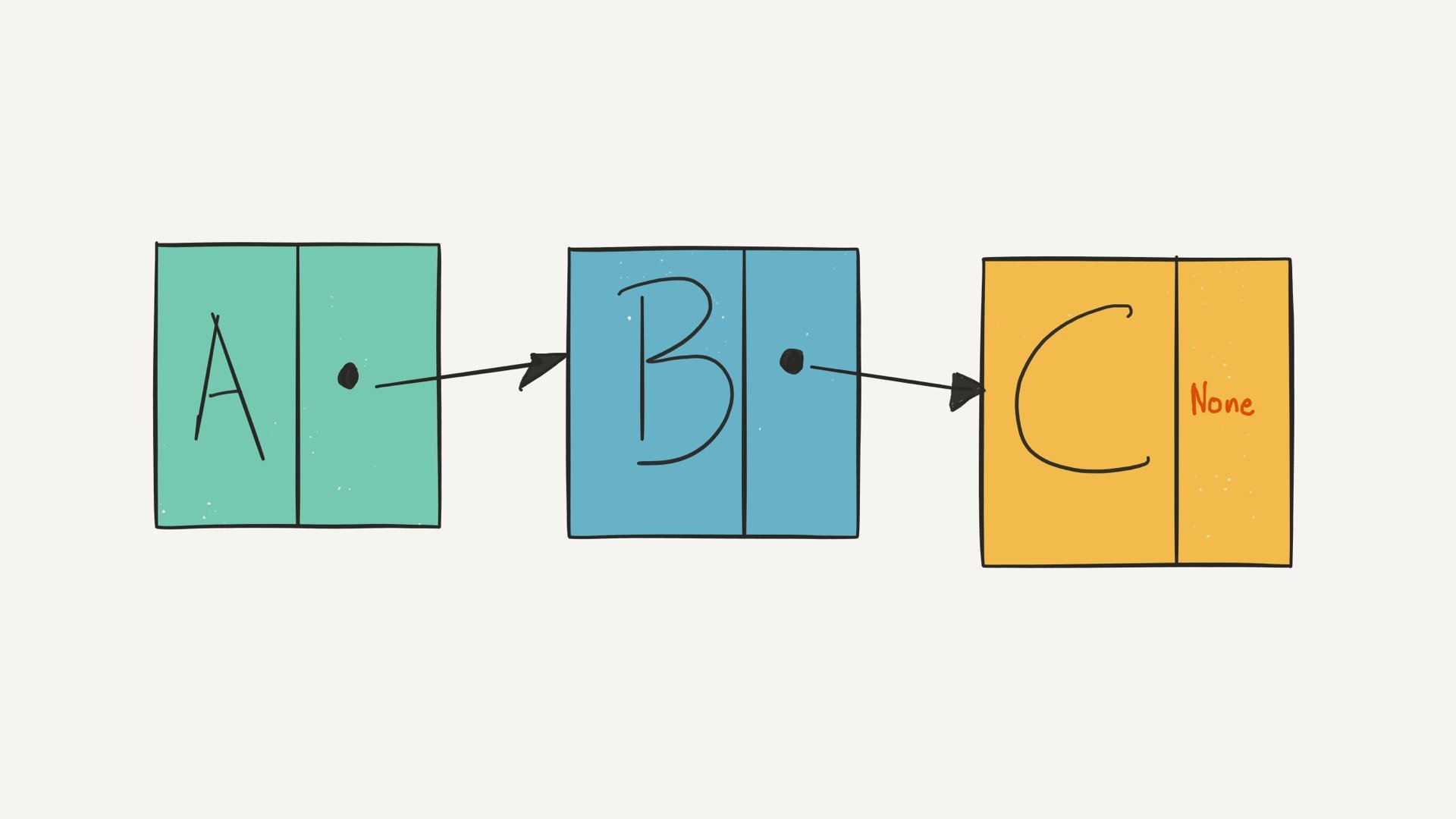Linked Lists in Python
Learn how to implement a linked list data structure in Python, using only built-in data types and functionality from the standard library.

Every Python programmer should know about linked lists:
They are among the simplest and most common data structures used in programming.
So, if you ever found yourself wondering, “Does Python have a built-in or ‘native’ linked list data structure?” or, “How do I write a linked list in Python?” then this tutorial will help you.
Python doesn’t ship with a built-in linked list data type in the “classical” sense. Python’s list type is implemented as a dynamic array—which means it doesn’t suit the typical scenarios where you’d want to use a “proper” linked list data structure for performance reasons.
Please note that this tutorial only considers linked list implementations that work on a “plain vanilla” Python install. I’m leaving out third-party packages intentionally. They don’t apply during coding interviews and it’s difficult to keep an up-to-date list that considers all packages available on Python packaging repositories.
Before we get into the weeds and look at linked list implementations in Python, let’s do a quick recap of what a linked list data structure is—and how it compares to an array.
What are the characteristics of a linked list?
A linked list is an ordered collection of values. Linked lists are similar to arrays in the sense that they contain objects in a linear order. However they differ from arrays in their memory layout.
Arrays are contiguous data structures and they’re composed of fixed-size data records stored in adjoining blocks of memory. In an array, data is tightly packed—and we know the size of each data record which allows us to quickly look up an element given its index in the array:

Linked lists, however, are made up of data records linked together by pointers. This means that the data records that hold the actual “data payload” can be stored anywhere in memory—what creates the linear ordering is how each data record “points” to the next one:

There are two different kinds of linked lists: singly-linked lists and doubly-linked lists. What you saw in the previous example was a singly-linked list—each element in it has a reference to (a “pointer”) to the next element in the list.
In a doubly-linked list, each element has a reference to both the next and the previous element. Why is this useful? Having a reference to the previous element can speed up some operations, like removing (“unlinking”) an element from a list or traversing the list in reverse order.
How do linked lists and arrays compare performance-wise?
You just saw how linked lists and arrays use different data layouts behind the scenes to store information. This data layout difference reflects in the performance characteristics of linked lists and arrays:
- Element Insertion & Removal: Inserting and removing elements from a (doubly) linked list has time complexity O(1), whereas doing the same on an array requires an O(n) copy operation in the worst case. On a linked list we can simply “hook in” a new element anywhere we want by adjusting the pointers from one data record to the next. On an array we have to allocate a bigger storage area first and copy around the existing elements, leaving a blank space to insert the new element into.
- Element Lookup: Similarly, looking up an element given its index is a slow O(n) time operation on a linked list—but a fast O(1) lookup on an array. With a linked list we must jump from element to element and search the structure from the “head” of the list to find the index we want. But with an array we can calculate the exact address of an element in memory based on its index and the (fixed) size of each data record.
- Memory Efficiency: Because the data stored in arrays is tightly packed they’re generally more space-efficient than linked lists. This mostly applies to static arrays, however. Dynamic arrays typically over-allocate their backing store slightly to speed up element insertions in the average case, thus increasing the memory footprint.
Now, how does this performance difference come into play with Python? Remember that Python’s built-in list type is in fact a dynamic array. This means the performance differences we just discussed apply to it. Likewise, Python’s immutable tuple data type can be considered a static array in this case—with similar performance trade-offs compared to a proper linked list.
Does Python have a built-in or “native” linked list data structure?
Let’s come back to the original question. If you want to use a linked list in Python, is there a built-in data type you can use directly?
The answer is: “It depends.”
As of Python 3.6 (CPython), doesn’t provide a dedicated linked list data type. There’s nothing like Java’s LinkedList built into Python or into the Python standard library.
Python does however include the collections.deque class which provides a double-ended queue and is implemented as a doubly-linked list internally. Under some specific circumstances you might be able to use it as a “makeshift” linked list. If that’s not an option you’ll need to write your own linked list implementation from scratch.
How do I write a linked list using Python?
If you want to stick with functionality built into the core language and into the Python standard library you have two options for implementing a linked list:
-
You could either use the
collections.dequeclass from the Python standard library and take advantage of the fact that it’s implemented as a doubly-linked list behind the scenes. But this will only work for some use cases—I’ll go into more details on that further down in the article. -
Alternatively, you could define your own linked list type in Python by writing it from scratch using other built-in data types. You’d implement your own custom linked list class or base your implementation of Lisp-style chains of
tupleobjects. Again, see below for more details.
Now that we’ve covered some general questions on linked lists and their availability in Python, read on for examples of how to make both of the above approaches work.
Option 1: Using collections.deque as a Linked List
This approach might seem a little odd at first because the collections.deque class implements a double-ended queue, and it’s typically used as the go-to stack or queue implementation in Python.
But using this class as a “makeshift” linked list might make sense under some circumstances. You see, CPython’s deque is powered by a doubly-linked list behind the scenes and it provides a full “list-like” set of functionality.
Under some circumstances, this makes treating deque objects as linked list replacements a valid option. Here are some of the key performance characteristics of this approach:
- Inserting and removing elements at the front and back of a
dequeis a fast O(1) operation. However, inserting or removing in the middle takes O(n) time because we don’t have access to the previous-element or next-element linked list pointers. That’s abstracted away by thedequeinterface. - Storage is O(n)—but not every element gets its own list node. The
dequeclass uses blocks that hold multiple elements at once and then these blocks are linked together as a doubly-linked list. As of CPython 3.6 the block size is 64 elements. This incurs some space overhead but retains the general performance characteristics given a large enough number of elements. - In-place reversal: In Python 3.2+ the elements in a
dequeinstance can be reversed in-place with thereverse()method. This takes O(n) time and no extra space.
Using collections.deque as a linked list in Python can be a valid choice if you mostly care about insertion performance at the beginning or the end of the list, and you don’t need access to the previous-element and next-element pointers on each object directly.
Don’t use a deque if you need O(1) performance when removing elements. Removing elements by key or by index requires an O(n) search, even if you have already have a reference to the element to be removed. This is the main downside of using a deque like a linked list.
If you’re looking for a linked list in Python because you want to implement queues or a stacks then a deque is a great choice, however.
Here are some examples on how you can use Python’s deque class as a replacement for a linked list:
>>> import collections >>> lst = collections.deque() # Inserting elements at the front # or back takes O(1) time: >>> lst.append('B') >>> lst.append('C') >>> lst.appendleft('A') >>> lst deque(['A', 'B', 'C']) # However, inserting elements at # arbitrary indexes takes O(n) time: >>> lst.insert(2, 'X') >>> lst deque(['A', 'B', 'X', 'C']) # Removing elements at the front # or back takes O(1) time: >>> lst.pop() 'C' >>> lst.popleft() 'A' >>> lst deque(['B', 'X']) # Removing elements at arbitrary # indexes or by key takes O(n) time again: >>> del lst[1] >>> lst.remove('B') # Deques can be reversed in-place: >>> lst = collections.deque(['A', 'B', 'X', 'C']) >>> lst.reverse() deque(['C', 'X', 'B', 'A']) # Searching for elements takes # O(n) time: >>> lst.index('X') 1
Option 2: Writing Your Own Python Linked Lists
If you need full control over the layout of each linked list node then there’s no perfect solution available in the Python standard library. If you want to stick with the standard library and built-in data types then writing your own linked list is your best bet.
You’ll have to make a choice between implementing a singly-linked or a doubly-linked list. I’ll give examples of both, including some of the common operations like how to search for elements, or how to reverse a linked list.
Let’s take a look at two concrete Python linked list examples. One for a singly-linked list, and one for a double-linked list.
✅ A Singly-Linked List Class in Python
Here’s how you might implement a class-based singly-linked list in Python, including some of the standard algorithms:
class ListNode: """ A node in a singly-linked list. """ def __init__(self, data=None, next=None): self.data = data self.next = next def __repr__(self): return repr(self.data) class SinglyLinkedList: def __init__(self): """ Create a new singly-linked list. Takes O(1) time. """ self.head = None def __repr__(self): """ Return a string representation of the list. Takes O(n) time. """ nodes = [] curr = self.head while curr: nodes.append(repr(curr)) curr = curr.next return '[' + ', '.join(nodes) + ']' def prepend(self, data): """ Insert a new element at the beginning of the list. Takes O(1) time. """ self.head = ListNode(data=data, next=self.head) def append(self, data): """ Insert a new element at the end of the list. Takes O(n) time. """ if not self.head: self.head = ListNode(data=data) return curr = self.head while curr.next: curr = curr.next curr.next = ListNode(data=data) def find(self, key): """ Search for the first element with `data` matching `key`. Return the element or `None` if not found. Takes O(n) time. """ curr = self.head while curr and curr.data != key: curr = curr.next return curr # Will be None if not found def remove(self, key): """ Remove the first occurrence of `key` in the list. Takes O(n) time. """ # Find the element and keep a # reference to the element preceding it curr = self.head prev = None while curr and curr.data != key: prev = curr curr = curr.next # Unlink it from the list if prev is None: self.head = curr.next elif curr: prev.next = curr.next curr.next = None def reverse(self): """ Reverse the list in-place. Takes O(n) time. """ curr = self.head prev_node = None next_node = None while curr: next_node = curr.next curr.next = prev_node prev_node = curr curr = next_node self.head = prev_node
And here’s how you’d use this linked list class in practice:
>>> lst = SinglyLinkedList() >>> lst [] >>> lst.prepend(23) >>> lst.prepend('a') >>> lst.prepend(42) >>> lst.prepend('X') >>> lst.append('the') >>> lst.append('end') >>> lst ['X', 42, 'a', 23, 'the', 'end'] >>> lst.find('X') 'X' >>> lst.find('y') None >>> lst.reverse() >>> lst ['end', 'the', 23, 'a', 42, 'X'] >>> lst.remove(42) >>> lst ['end', 'the', 23, 'a', 'X'] >>> lst.remove('not found')
Note that removing an element in this implementation is still an O(n) time operation, even if you already have a reference to a ListNode object.
In a singly-linked list removing an element typically requires searching the list because we need to know the previous and the next element. With a double-linked list you could write a remove_elem() method that unlinks and removes a node from the list in O(1) time.
✅ A Doubly-Linked List Class in Python
Let’s have a look at how to implement a doubly-linked list in Python. The following DoublyLinkedList class should point you in the right direction:
class DListNode: """ A node in a doubly-linked list. """ def __init__(self, data=None, prev=None, next=None): self.data = data self.prev = prev self.next = next def __repr__(self): return repr(self.data) class DoublyLinkedList: def __init__(self): """ Create a new doubly linked list. Takes O(1) time. """ self.head = None def __repr__(self): """ Return a string representation of the list. Takes O(n) time. """ nodes = [] curr = self.head while curr: nodes.append(repr(curr)) curr = curr.next return '[' + ', '.join(nodes) + ']' def prepend(self, data): """ Insert a new element at the beginning of the list. Takes O(1) time. """ new_head = DListNode(data=data, next=self.head) if self.head: self.head.prev = new_head self.head = new_head def append(self, data): """ Insert a new element at the end of the list. Takes O(n) time. """ if not self.head: self.head = DListNode(data=data) return curr = self.head while curr.next: curr = curr.next curr.next = DListNode(data=data, prev=curr) def find(self, key): """ Search for the first element with `data` matching `key`. Return the element or `None` if not found. Takes O(n) time. """ curr = self.head while curr and curr.data != key: curr = curr.next return curr # Will be None if not found def remove_elem(self, node): """ Unlink an element from the list. Takes O(1) time. """ if node.prev: node.prev.next = node.next if node.next: node.next.prev = node.prev if node is self.head: self.head = node.next node.prev = None node.next = None def remove(self, key): """ Remove the first occurrence of `key` in the list. Takes O(n) time. """ elem = self.find(key) if not elem: return self.remove_elem(elem) def reverse(self): """ Reverse the list in-place. Takes O(n) time. """ curr = self.head prev_node = None while curr: prev_node = curr.prev curr.prev = curr.next curr.next = prev_node curr = curr.prev self.head = prev_node.prev
Here are a few examples on how to use this class. Notice how we can now remove elements in O(1) time with the remove_elem() function if we already hold a reference to the list node representing the element:
>>> lst = DoublyLinkedList() >>> lst [] >>> lst.prepend(23) >>> lst.prepend('a') >>> lst.prepend(42) >>> lst.prepend('X') >>> lst.append('the') >>> lst.append('end') >>> lst ['X', 42, 'a', 23, 'the', 'end'] >>> lst.find('X') 'X' >>> lst.find('y') None >>> lst.reverse() >>> lst ['end', 'the', 23, 'a', 42, 'X'] >>> elem = lst.find(42) >>> lst.remove_elem(elem) >>> lst.remove('X') >>> lst.remove('not found') >>> lst ['end', 'the', 23, 'a']
Both example for Python linked lists you saw here were class-based. An alternative approach would be to implement a Lisp-style linked list in Python using tuples as the core building blocks (“cons pairs”). Here’s a tutorial that goes into more detail: Functional Linked Lists in Python.
Python Linked Lists: Recap & Recommendations
We just looked at a number of approaches to implement a singly- and doubly-linked list in Python. You also saw some code examples of the standard operations and algorithms, for example how to reverse a linked list in-place.
You should only consider using a linked list in Python when you’ve determined that you absolutely need a linked data structure for performance reasons (or you’ve been asked to use one in a coding interview.)
In many cases the same algorithm implemented on top of Python’s highly optimized list objects will be sufficiently fast. If you know a dynamic array won’t cut it and you need a linked list, then check first if you can take advantage of Python’s built-in deque class.
If none of these options work for you, and you want to stay within the standard library, only then should you write your own Python linked list.
In an interview situation I’d also advise you to write your own implementation from scratch because that’s usually what the interviewer wants to see. However it can be beneficial to mention that collections.deque offers similar performance under the right circumstances. Good luck and…Happy Pythoning!
Read the full “Fundamental Data Structures in Python” article series here. This article is missing something or you found an error? Help a brother out and leave a comment below.

